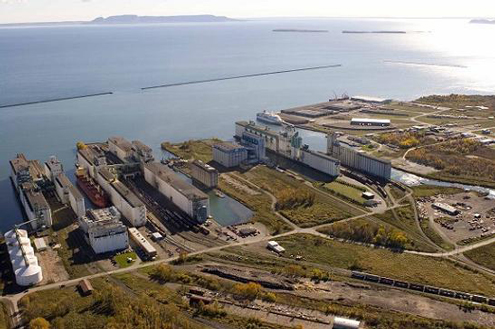 THUNDER BAY – Today, mayors of the Great Lakes and St. Lawrence Cities Initiative called on the American and Canadian Federal Governments to build on the U.S. Great Lakes Restoration Initiative and local investments by making a bi-national sustainable commitment to the region, supported by long-term funding.
THUNDER BAY – Today, mayors of the Great Lakes and St. Lawrence Cities Initiative called on the American and Canadian Federal Governments to build on the U.S. Great Lakes Restoration Initiative and local investments by making a bi-national sustainable commitment to the region, supported by long-term funding.
“Mayors and their communities continue to assume a strong leadership role on the Great Lakes and St. Lawrence,” said Mayor Keith Hobbs. “Our actions highlighted at the Annual meeting in Niagara Falls this year are yet another example of this leadership.”
“Protecting and restoring the world’s largest freshwater resource and source of drinking water for 40 million people must be a priority for our two countries,” added Mayor Brian McMullan of St. Catharines and chair of the Cities Initiative. “The U.S. Great Lakes Restoration Initiative should serve as a model at the bi-national level and create a shared commitment which will require support through significant investments from both Canada and the U.S. to become a reality.”
Mayors welcomed the U.S. Great Lakes Restoration Initiative, under which the U.S. Federal Government committed $475 million in 2010 for non-infrastructure protection and restoration projects in the Great Lakes region. On a per capita basis, that represents about $15 per year for each of the 32 million Americans living in the Great Lakes basin.
“The Mayors of the Great Lakes and St. Lawrence appreciate the US federal government’s commitment to local investment in Great Lakes protection through the Great Lakes Restoration Initiative,” said Mayor Tom Barrett of Milwaukee, vice chair of the Cities Initiative. “We hope to continue to strengthen this partnership and collaboration for the betterment of the Lakes.”
Investments are needed to respond to the enormous challenges facing the Great Lakes and St. Lawrence and local communities. These include the eutrophication of Lake Erie and Lake Ontario, adapting cities to climate change, protecting shorelines, and preserving wetlands and other coastal habitat areas. This infusion into non-infrastructure projects and programs would be complementary to major investments that are needed to address the multi-billion dollar deficit for water infrastructure in both countries.
“We call on the Canadian Government to match U.S. Great Lakes investments on a per capita basis, committing $15 per year for every one of the 19 million Great Lakes and St. Lawrence Canadian citizens, or $285 million per year for non-infrastructure, local protection and restoration projects,” said Mayor Régis Labeaume of Quebec City, president of the Quebec Metropolitan Community and Cities Initiative secretary/treasurer.
Great Lakes and St. Lawrence cities on both sides of the border are realizing significant returns from their investments in efforts to protect and restore the Great Lakes and St. Lawrence River. Cities invest more than $15 billion annually to protect and restore the Great Lakes and St. Lawrence.
“Our protection and restoration investments yield high positive returns for our communities,” said Gary Burroughs, Chair of the Niagara Region and host of the 2011 Cities Initiative Annual Meeting. “Today we are highlighting these returns to demonstrate why all orders of government must continue to invest in this global resource.“
The returns from Great Lakes-St. Lawrence investments are real and broad-reaching. The Brookings Institution found that for a $26 billion investment in the Great Lakes, there would be over a $50 billion return in economic benefits. In addition, the National Association of Clean Water Agencies estimates that 47,000 jobs are created for every billion dollars invested in clean water infrastructure. Municipal investments have also shown great returns, in terms of economic and environmental development and quality of life.
• Milwaukee is redeveloping and revitalizing an old industrial corridor located along the Menomonee River, now known as the Menomonee Valley Industrial Center and Community. The $54 million project, of which Milwaukee and the Milwaukee Metropolitan Sewerage District are investing more than $24 million, will ultimately create an estimated 1,075 jobs by 2012.
• The City of Trois-Rivières, situated on the banks of the St. Lawrence River, has adopted a goal of preserving one acre of land for every acre developed, in order to protect the biodiversity of the region. In just over a year and a half, the city has already preserved 316 acres with rich ecosystem and biodiversity potential.
• As a result of the City of Racine’s North Beach restoration and revitalization work, North Beach has not posted a beach closure since 2007 and the city can net almost $2 million per summer just from overnight stays associated with two major sporting events that make use of the beach.
• The Municipality of Chatham-Kent and the Lower Thames Valley Conservation Authority work together on the “Greening/Reforestation Partnership” which includes an Annual Tree Program. As part of the municipality’s investment and other funding sources, three full-time and two to three seasonal positions have been created. Over 146 acres of land has been naturally restored.
More information on Great Lakes and St. Lawrence cities’ “blue” investments can be found at www.glslcities.org/annual-meetings/2011/media.cfm.
The Great Lakes and St. Lawrence Cities Initiative is a bi-national coalition of over 80 mayors and other local officials that works actively with federal, state, tribal, first nation and provincial governments and other stakeholders to advance the protection, restoration and promotion of the Great Lakes and St. Lawrence River basin.

